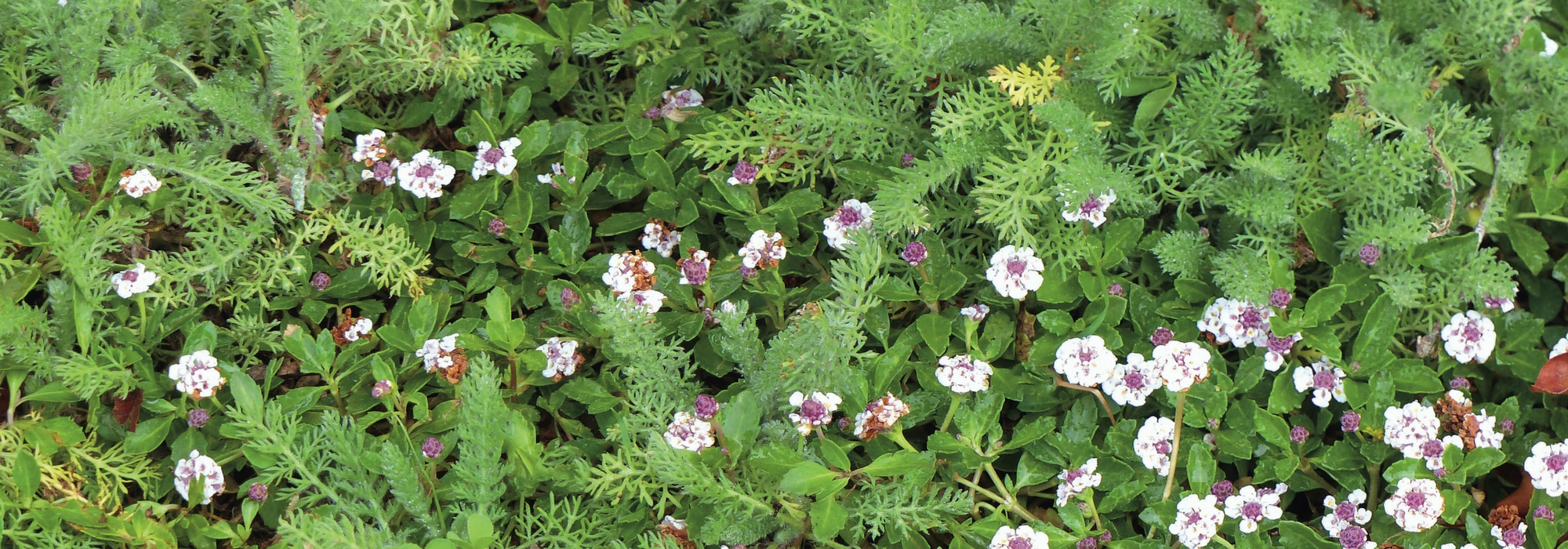
Alternatives to grass: 10 ground covers to replace short grass meadow
Stepable plants for all situations
Contents
A beautiful short grass meadow, dense and green, even in summer, is a dream that many gardeners can only achieve with extensive watering, especially in dry climates. And everywhere else, where herbs grow, they require maintenance: regular mowing, scarification, fertilisation…
The solution? Alternative plants to lawn!
These perennial ground covers stand out from traditional ground covers by their resistance to trampling, drought, or their ability to spread spontaneously. Ecological and very easy to care for, these “carpet plants” perfectly replace traditional lawns in small gardens, forming a lovely green carpet.
Choosing the right plants to replace grass
First of all, it is important to know that the plants offered as an alternative to short grass meadows can all withstand foot traffic, but to varying degrees depending on the species. However, they are not suitable for intensive use: you will never achieve the same resilience or appearance as a “sports and play” type of short grass meadow. Furthermore, some plants require no mowing at all, while others, such as yarrow, will need a “little refresh” once or twice a year.
To choose your ground covers wisely, we recommend carefully assessing two essential elements:
- the soil and the exposure of the area to be planted in order to select varieties that are perfectly suited,
- the level of foot traffic in the spaces you wish to develop, taking into account, as with a carpet, the level of passage (occasional, low, moderate, intensive). In the case of a path that is frequently used, we advise installing slabs or Japanese stepping stones, which will help prevent your plants from being overly stressed on one hand, and broaden your range of choices on the other.
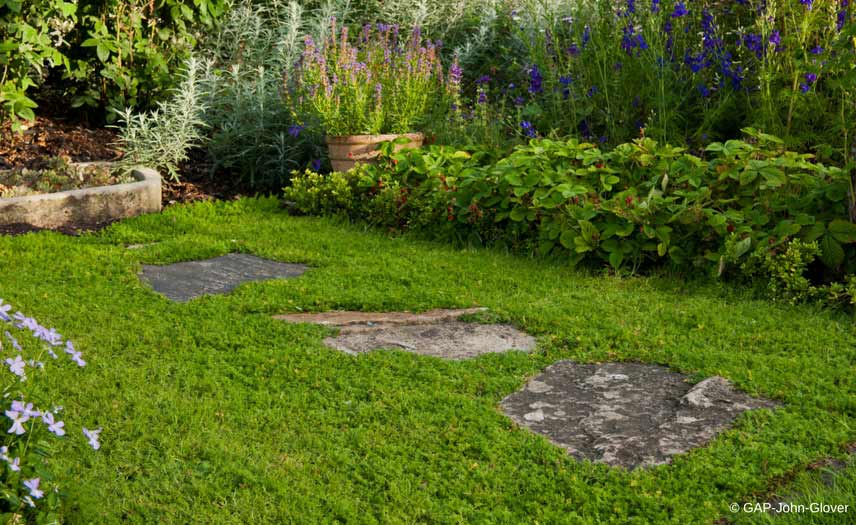 A short grass meadow of chamomile nobile Treneague
A short grass meadow of chamomile nobile Treneague
Moreover (and even though anything is always possible in theory), note that these alternatives are mainly reserved for small spaces. If you wish to remove the short grass meadow from larger areas, we recommend installing flower beds of the meadow type where perennials and grasses are mixed.
Read also
Achillea : plant, cultivate and maintainAlternatives to grass for dry to very dry soil and locations
A dry, stony soil is the main obstacle to establishing a traditional lawn. And when one succeeds, it is very difficult to maintain a beautiful appearance in summer, unless one resorts to expensive watering. Fortunately, a few plants can advantageously replace the herb in these situations.
Alternatives to grass for cool, moist soil and locations
Replacing short grass meadow herb is also possible in cooler or even damp soil as well as in shade. Although grasses generally grow well there, these ground-cover plants will help minimise maintenance. They are ideal for hard-to-reach areas.
Pairing these ground covers: advantages and precautions to take
All these plants associate well with each other, it is even recommended to mix them. Indeed, this allows for:
- creating a visually more attractive tapetum, by playing with different foliage shapes and flower colours for thymes or even the pratia (the variety ‘County Park’ offers deep blue flowers)
- promoting better “resilience” of the tapetum. This concept, often used in psychology, also applies to plants. It refers to the ability of plants to recover after significant disturbances such as prolonged drought or intensive trampling during a “garden party”… When these ground covers are associated with each other, this ability is strengthened as neighbouring plants will help those in danger to regain strength, by providing nitrogen, for example.
- having a “green” effect over a longer period, by associating plants with complementary vegetative cycles.
To create a lovely diverse short grass meadow, you can, for example, mix Achillea crithmifolia and Lippia nodiflora or several species of thymes, which will form a beautiful gradient.
Precautions to take:
These plants are selected for their ability to spread as a tapetum, but they do not all behave the same way: some remain contained while others tend to spread rapidly and vigorously, like the Pratia pedunculata. Beyond the aesthetic aspect, their dynamics is therefore an element that must be taken into account to prevent the more aggressive plants from smothering their neighbours.
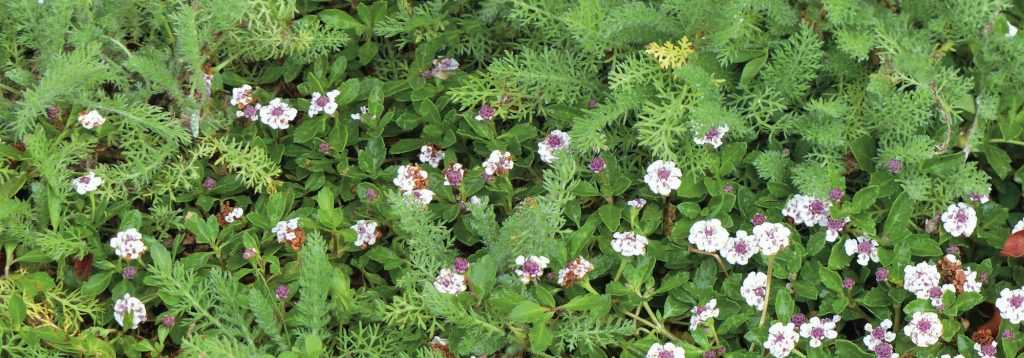
Achillea crithmifolia and Lippia nodiflora mixed
Successfully Installing Them in the Garden: The Conditions for Success
Although easy, the installation of these ground covers should not be improvised. To successfully establish them, it is important to follow a few rules:
1) Pay attention to soil preparation
As with any planting, soil preparation is essential. We recommend proceeding as if you were about to sow grass: loosen your soil to a depth of 30 to 40 cm, break up large clumps with a fork, weed thoroughly, and then rake until you achieve a surface similar to a seedbed.
2) Space the plants correctly
Do not skimp on the number of plants per m², but respect the recommended planting distances (generally 20 to 40 cm depending on the species). A gap that is too large between the plants would leave holes. Conversely, if planted too closely, your plants may suffocate each other.
3) Take care of weeding
The first few months following the establishment of a grass substitute are crucial, as this is when adventives (“weeds”) take advantage of the free spaces to settle: carry out regular weeding so that your plants can spread without competition. Note that these weeding efforts can only be done by hand: the use of a chemical herbicide (soon to be banned) is not an option. To avoid this weeding, the use of a mulch fabric is not possible: it is not recommended for any plant, let alone for these ground covers that need a naked or very lightly mulched soil to spread. Excessive mulching would hinder the rooting of plants like thyme.
4) Water them occasionally during the first summer
Once well established, most of these plants are drought-resistant. However, in the case of a particularly hot summer, remember to support their establishment by watering them occasionally.
Maintenance
The low maintenance level is one of the main advantages of this type of short grass meadow. However, a few very occasional tasks are to be expected.
These consist of:
- occasional weeding, in case any adventive plants manage to find a small free space to settle in,
- limiting the most vigorous plants,
- mowing once or twice a year, if necessary. This task can be done with shears, a strimmer, or even a mower for larger, easily accessible areas, by setting the blade to a high position.
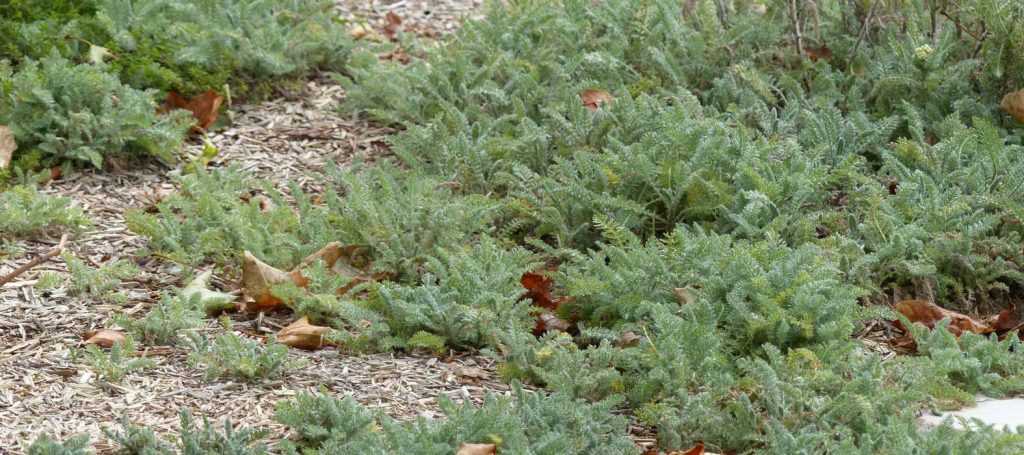
Maintenance of an Achillea crithmifolia short grass meadow consists of one or two annual mowings to remove dried flowers.
Other possible uses
We have seen that these very low ground cover plants are a great alternative to grass. They can also be used in other situations, such as for:
- creating a dry garden or “gravel garden”,
- filling a rockery where they will thrive between stones and rocks,
- covering a small bank,
- elegantly filling the gaps between the slabs of a very natural terrace or a mineral-dominated garden,
- dressing the base of trees where the soil is often very dry,
- greening a paved surface, provided the joints are wide enough,
- creating trendy mini-gardens in pots or troughs!
In other arrangements, these plants can also be combined with alpine perennials, rock garden plants, or dry soil plants such as lavenders, wormwood, Armeria maritima… (rockeries, dry and Mediterranean gardens…) and with perennials typically intended for borders, in cooler soil.
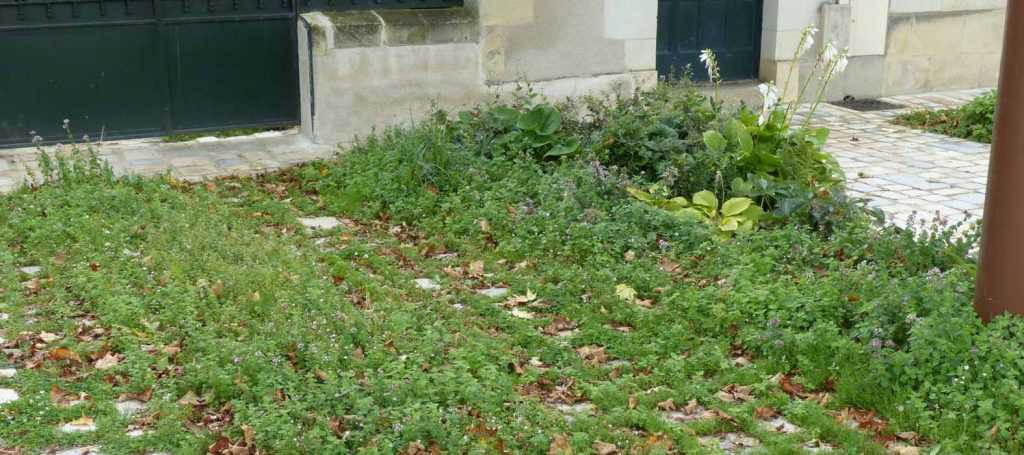
A paved and greened garage entrance
Did you know?
In everyday language, the word “short grass meadow” is often used to refer to lawn. However, in botany, the term short grass meadow does not refer to a large expanse of green grass but to a community of plant species composed of low herbaceous plants (20 to 30 cm tall) as well as small bushes. There are different types of short grass meadows (calcareous short grass meadows, dune short grass meadows…), all of which host a great diversity.
- Subscribe!
- Contents































Comments